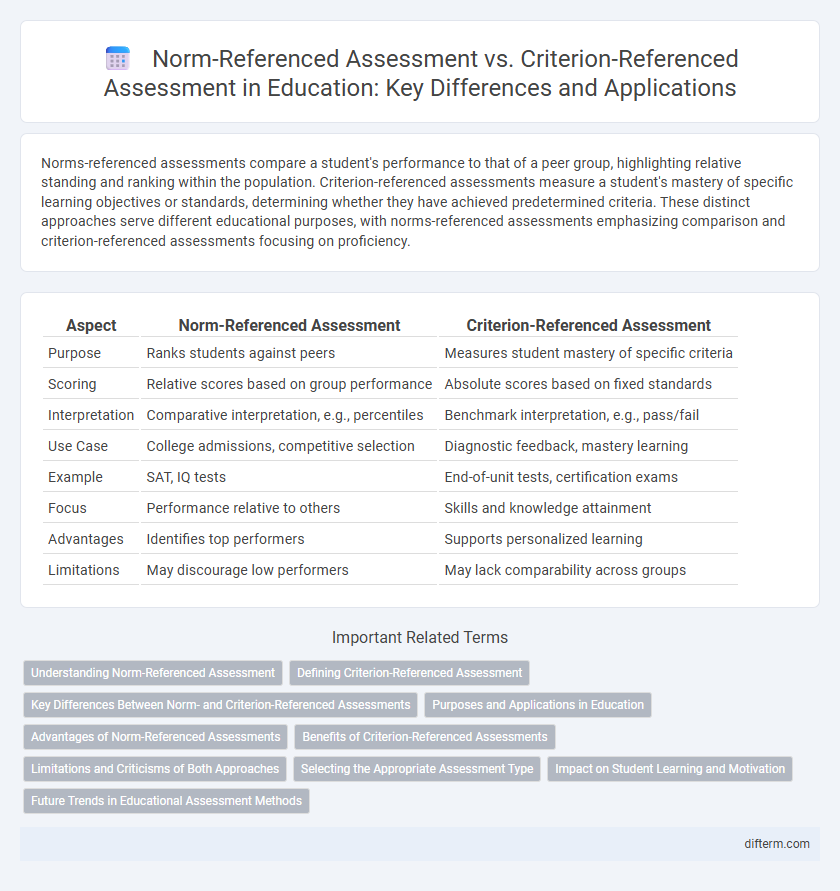Norms-referenced assessments compare a student's performance to that of a peer group, highlighting relative standing and ranking within the population. Criterion-referenced assessments measure a student's mastery of specific learning objectives or standards, determining whether they have achieved predetermined criteria. These distinct approaches serve different educational purposes, with norms-referenced assessments emphasizing comparison and criterion-referenced assessments focusing on proficiency.
Table of Comparison
| Aspect | Norm-Referenced Assessment | Criterion-Referenced Assessment |
|---|---|---|
| Purpose | Ranks students against peers | Measures student mastery of specific criteria |
| Scoring | Relative scores based on group performance | Absolute scores based on fixed standards |
| Interpretation | Comparative interpretation, e.g., percentiles | Benchmark interpretation, e.g., pass/fail |
| Use Case | College admissions, competitive selection | Diagnostic feedback, mastery learning |
| Example | SAT, IQ tests | End-of-unit tests, certification exams |
| Focus | Performance relative to others | Skills and knowledge attainment |
| Advantages | Identifies top performers | Supports personalized learning |
| Limitations | May discourage low performers | May lack comparability across groups |
Understanding Norm-Referenced Assessment
Norm-referenced assessment measures a student's performance by comparing it to a predefined group, typically using percentile ranks to indicate relative standing. This assessment type helps identify how individuals perform in relation to peers, often guiding placement or selection decisions. Understanding norm-referenced assessment is essential for interpreting standardized test scores and recognizing their role in evaluating overall academic achievement.
Defining Criterion-Referenced Assessment
Criterion-referenced assessment evaluates a student's performance against fixed learning objectives or criteria, rather than comparing results with peers. This type of assessment measures mastery of specific skills or knowledge, providing clear indicators of what a student can or cannot do. Common examples include state standardized tests and mastery checks aligned with curriculum standards.
Key Differences Between Norm- and Criterion-Referenced Assessments
Norm-referenced assessments rank students by comparing their performance to peers, often using percentiles or standard scores, while criterion-referenced assessments measure student achievement against predefined learning standards or objectives. Norm-referenced tests are designed to identify relative standing within a group, whereas criterion-referenced tests determine mastery of specific skills or content regardless of group performance. Key differences include purpose, scoring methods, and interpretation, impacting instructional decisions and student evaluation in educational settings.
Purposes and Applications in Education
Norm-referenced assessments rank students by comparing their performance to a peer group, primarily used for identifying relative achievement, selecting candidates, and diagnosing learning gaps. Criterion-referenced assessments measure student performance against predefined learning objectives, supporting mastery learning, guiding instructional planning, and evaluating curriculum effectiveness. Both assessments play critical roles in educational decision-making by providing distinct insights into student abilities and instructional outcomes.
Advantages of Norm-Referenced Assessments
Norm-referenced assessments provide educators with comparative data by ranking students against their peers, facilitating the identification of high and low performers within a group. These assessments are advantageous for screening purposes, admissions, and selection processes due to their ability to highlight relative achievement levels. They support instructional decisions by pinpointing students who may require additional resources or challenges, enhancing tailored educational interventions.
Benefits of Criterion-Referenced Assessments
Criterion-referenced assessments provide clear benchmarks that measure student performance against specific learning objectives, enabling targeted instructional strategies. These assessments facilitate personalized feedback, helping educators identify individual strengths and areas for improvement without comparing students to their peers. By aligning directly with curriculum standards, criterion-referenced assessments support consistent evaluation and promote mastery of subject matter.
Limitations and Criticisms of Both Approaches
Norm-referenced assessments face criticism for promoting competition among students and failing to provide specific information about individual learning progress, often leading to widened achievement gaps. Criterion-referenced assessments are limited by rigid standards that may not account for diverse learning styles or contextual factors, potentially overlooking individual growth and deeper understanding. Both approaches struggle to balance fairness and accuracy, with norm-referenced tests emphasizing relative performance and criterion-referenced tests focusing on fixed benchmarks.
Selecting the Appropriate Assessment Type
Selecting the appropriate assessment type depends on instructional goals and student needs; norm-referenced assessments compare a student's performance against a peer group, while criterion-referenced assessments measure mastery of specific learning objectives. Norm-referenced tests are effective for identifying relative student rankings and eligibility for programs, whereas criterion-referenced assessments provide detailed information about individual proficiency and curriculum effectiveness. Aligning assessment type with educational standards and learning outcomes ensures valid measurement of student achievement and guides targeted instruction.
Impact on Student Learning and Motivation
Norm-referenced assessment ranks students against each other, often leading to competitive environments that can decrease motivation for lower-performing learners while encouraging high achievers to excel. Criterion-referenced assessment measures student performance against fixed learning standards, promoting mastery of content and fostering intrinsic motivation by highlighting individual progress. Research shows that criterion-referenced assessments enhance student confidence and support targeted instruction, resulting in improved learning outcomes.
Future Trends in Educational Assessment Methods
Future trends in educational assessment methods emphasize integrating adaptive technology to enhance both norms-referenced and criterion-referenced assessments. Advances in machine learning and data analytics support personalized evaluation, enabling real-time adjustments to assessment difficulty based on student performance. This shift promotes more accurate measurement of individual learning progress while maintaining comparative benchmarks across diverse student populations.
norms-referenced assessment vs criterion-referenced assessment Infographic

 difterm.com
difterm.com